In recent research conducted within the Namadope reservoir located in the Luuka district of Uganda, scientists have aimed to unravel the complexities of sediment composition and the dynamics of settling velocities. This study, led by Omar A.S., Kannapiran A., and Mogaka D., showcases an emerging interest in understanding how sediment behavior affects aquatic ecosystems, particularly within local water bodies that are vital for community resources and ecological balance.
Sediments in aquatic environments are critical for various reasons, as they influence water quality, habitat structure, and nutrient availability. The Namadope reservoir, like many others, serves as a strategic resource for local communities, providing opportunities for fishing, irrigation, and recreational activities. However, the study of sediment characteristics often eludes public attention despite their profound impacts on ecological health and water management practices.
One of the primary goals of this research was to analyze the different types of sediments present in the reservoir. Following a systematic methodology, researchers collected sediment samples from various regions within the reservoir. Each sample was subjected to rigorous laboratory analyses to assess its composition, which included examining the mineralogical and chemical properties. The results illuminated the variable nature of sediments in terms of texture, size, and organic content, providing an in-depth perspective into how these factors might influence aquatic life.
In addition to composition analysis, the researchers also focused on sediment settling velocities—an equally critical factor in aquatic environments. Settling velocity refers to the rate at which particles settle downward through water, a process influenced by particle size, shape, and density, among other physical properties. Understanding settling velocities holds importance not only for sediment transport but also for water clarity and ecosystem health. This analysis is essential because sediments affect light penetration in water, impacting the photosynthesis of aquatic plants and the overall productivity of the ecosystem.
The researchers employed a variety of statistical tools and models to determine the relationship between sediment characteristics and their settling velocities. The findings indicated variations in settling velocities across different sediment types, suggesting that finer particles sank more slowly due to their low density and increased surface area, which enhances the effects of turbulence in the water column. This complex dynamic emphasizes that sediment management practices must consider not only the composition of the sediment but also how these sediments behave within the aquatic environment.
Moreover, the study’s implications extend beyond the immediate confines of Namadope. Globally, nations are looking for sustainable methods to manage water resources, especially in regions affected by climate change. Understanding sediment behavior in local reservoirs can serve as a model for other regions facing similar ecological challenges. This research is critical not only for managing water quality but also for preserving biodiversity within these ecosystems.
One noteworthy finding of the study was the identification of distinct sediment zones within the Namadope reservoir. These zones were characterized by unique sediment properties that reflect the physical and biological interactions occurring within each microenvironment. Such zones could provide vital habitats for various aquatic organisms, highlighting the need for tailored management strategies that account for the multifaceted nature of sediment dynamics.
The research team also underscored the importance of continued monitoring of sediment characteristics over time. Environmental conditions are in constant flux, influenced by factors such as seasonal changes, human activities, and ecological interactions. Regular assessments can help detect shifts in sediment composition or settling behavior that may arise from environmental disturbances or anthropogenic influences. Early detection of such changes is crucial for implementing effective management practices aimed at sustaining reservoir health.
Furthermore, the study serves as a reminder of the interconnectedness of land use, sediment transport, and water quality. Agricultural practices, urban development, and deforestation all play significant roles in influencing sediment supply and characteristics in aquatic systems. Educating local communities and stakeholders about these connections can facilitate more sustainable land use practices that ultimately benefit both the reservoir and the communities that rely on it.
In light of this research, the significance of sediment studies becomes clear. As water bodies are increasingly subjected to degradation and pollution, understanding sediment dynamics will be essential to implementing strategies that promote resilience and recovery. The findings from the Namadope reservoir research contribute valuable insights to the broader discourse on aquatic ecology and environmental sustainability, emphasizing the continued need for scientific investigation in our waterscapes.
In summary, the study on sediment composition and settling velocities in the Namadope reservoir addresses a crucial gap in our understanding of freshwater ecosystems. It highlights the intricate interplay between sediment characteristics, aquatic health, and management practices. With the growing concerns around water security and environmental sustainability, research like this is integral to developing tailored management strategies that can support both local ecological health and community resources.
As we continue to confront the challenges posed by climate change and environmental degradation, studies such as this will remain invaluable. They enhance our understanding, inform decision-making, and encourage collaborative efforts toward sustainable management of precious water resources.
The research not only deepens the scientific community’s knowledge but also stands as a call to action for local governments, policymakers, and stakeholders to prioritize sediment studies within broader environmental management frameworks. Continuously engaging with and investing in our natural resources ensures a future where communities can thrive alongside robust ecosystems.
In conclusion, the insights gained from Omar, Kannapiran, and Mogaka’s research shed light on the pivotal role of sediment studies in sustaining our aquatic environments. As the efforts to protect and manage these invaluable ecosystems progress, it is critical that such scientific endeavors receive the attention and support they warrant.
Subject of Research: Sediment composition and settling velocities in the Namadope reservoir
Article Title: Determining sediment composition and settling velocities of Namadope reservoir in Luuka district, Uganda
Article References: Omar, A.S., Kannapiran, A. & Mogaka, D. Determining sediment composition and settling velocities of Namadope reservoir in Luuka district, Uganda. Discov Sustain 6, 899 (2025). https://doi.org/10.1007/s43621-025-01660-5
Image Credits: AI Generated
DOI:
Keywords: Sediment composition, settling velocity, Namadope reservoir, aquatic ecosystems, environmental sustainability.




